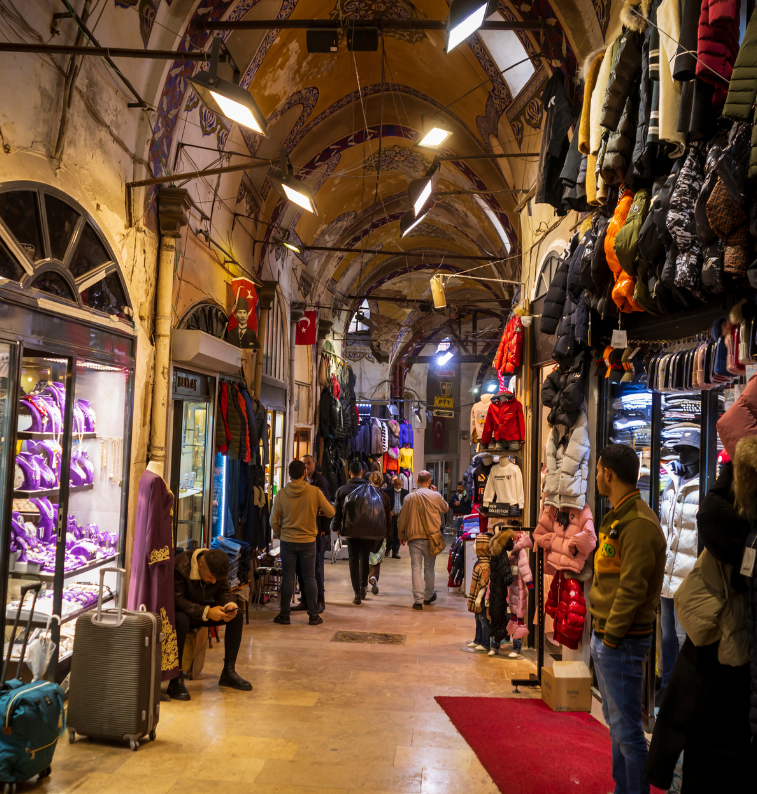India, a country known for its diverse population, rich history, and rich tapestry of culture, has a market that reflects this diversity. Every market in India has a unique narrative to tell and offers a fascinating kaleidoscope of hues, noises, and aromas. The nation's marketplaces, which range from large modern malls to busy street bazaars, are a reflection of its multifaceted nature. Let's discover the numerous markets that are successful in India as we plunge into this sparkling world.

Types of Markets in India
India, with its diverse economic landscape, has a myriad of market types catering to different sectors, products, and consumer segments. Here's a breakdown of the various types of markets that can be found across the country:
-
Traditional Street Markets
India's bustling street marketplaces are one of the country's most recognizable pictures. Chandni Chowk in Delhi, Colaba Causeway in Mumbai, or Johari Bazaar in Jaipur are examples of locations that are more than just centers for shopping; they are experiences. You can find wonderful handicrafts, fragrant spices, sparkling jewelry, and some of the best street cuisine India has to offer among the pandemonium.
Fun Fact: The bustling market of Chandni Chowk dates back to the 17th century and remains one of the oldest markets in Delhi.
-
Flea Markets
Flea markets, such as the ones in Goa's Anjuna or Delhi's Dilli Haat, offer a bohemian experience. These markets are treasure troves where you can find anything from vintage items, handicrafts, clothing, to exotic jewelry and souvenirs.
-
Farmer's and Fish Markets
Offering the freshest produce, these markets are a vital part of India's agrarian economy. The early morning fish markets along India's coastline, particularly in cities like Mumbai, Chennai, and Kochi, are a hive of activity.
-
Modern Malls and Supermarkets
India has seen an increase in the number of contemporary supermarkets and shopping malls with the advent of globalization. These are the locations that provide a mix of domestic and foreign brands, frequently accompanied by food courts, theaters, and leisure areas.
-
Wholesale Markets
These markets deal in bulk quantities and primarily serve as sourcing points for retailers. Delhi's Sadar Bazaar and Mumbai's Dharavi leather market are examples.
-
Floating Markets
Markets on boats or makeshift platforms on water. The floating vegetable market on Dal Lake in Srinagar is a unique instance.
-
Street Food Markets
Concentrated zones where multiple street food vendors sell local delicacies. Parathe Wali Gali in Delhi is a renowned spot.
-
Craft and Handicraft Markets
Markets focusing on handmade goods and crafts. Dilli Haat in Delhi offers crafts from all over India.
-
Modern Retail Markets
These include shopping malls, supermarkets, and hypermarkets which offer a wide range of branded products under one roof.
-
Online and E-commerce Markets
Digital marketplaces like Amazon India, Flipkart, and Snapdeal cater to the online shopping trends.

Economic Scenario:
India's markets are essential to its economy. The retail sector in India is anticipated to expand tremendously, driven by greater urbanization, rising incomes, and the proliferation of digital technology as of my most recent report in January 2022. The traditional market is evolving into a digital one as e-commerce giants like Flipkart, Amazon India, and Reliance JioMart make substantial inroads. Let's examine India's markets' economic significance in more detail:
-
Employment Generation
Traditional markets, small businesses, and retail stores employ a significant portion of the Indian population. Street vendors, craftsmen, and shopkeepers make a living from these markets.
-
Contribution to GDP
Retail markets contribute significantly to India's Gross Domestic Product (GDP). The Indian retail industry, encompassing both organized and unorganized sectors, is one of the major pillars of its economy.
-
Facilitating Trade
Markets, especially wholesale ones, play a crucial role in trade. Mandis (agricultural markets) in various parts of the country, for example, facilitate the buying and selling of agricultural produce, ensuring that farmers have a place to sell their goods.
-
Consumer Price Determination
The demand and supply dynamics in markets play a fundamental role in determining consumer prices. An efficient and competitive market system can lead to price stabilization, benefiting consumers.
-
Promotion of Local Artisans and Craftsmen
Regional markets in India promote local arts, crafts, and traditional products. This not only preserves cultural heritage but also provides livelihoods to artisans.
-
Boost to Tourism
Many traditional markets in India are major tourist attractions. International and domestic tourists flock to markets like Jaipur's Johari Bazaar, Delhi's Chandni Chowk, or Goa's Anjuna flea market. This indirectly promotes the hospitality and tourism sector.
-
Channel for Innovation and Entrepreneurship
New ideas, products, and business models often find their testing grounds in local markets. With the rise of digital India, online marketplaces and e-commerce platforms have further expanded the horizon for innovators and entrepreneurs.
-
Foreign Investment
The potential and growth of Indian markets have attracted foreign investors and global retail giants. As regulations ease, foreign direct investment (FDI) in the retail sector has seen a considerable increase.
-
Socioeconomic Development
Markets in rural areas play a vital role in the socioeconomic development of the region. They act as hubs for not only trade but also social interaction, dissemination of information, and cultural exchange.
-
Economic Linkages
Markets establish linkages between rural and urban economies. Goods produced in rural areas find consumers in urban markets, and vice-versa, ensuring that money circulates within the economy.
-
Digital Transformation & Financial Inclusion
With the growth of digital payment platforms and e-commerce, even small vendors are now part of the formal financial system. This promotes financial inclusion, giving many access to banking services and credit.
In conclusion, India's markets are more than just locations for transactional trades; they are economic engines that propel growth, encourage innovation, and direct the course of the nation's economy. These markets continue to be at the center of India's thriving economy, whether through the hum of a neighborhood bazaar or the click of an online transaction.

Real Estate Scenario:
India's real estate has been significantly impacted by the growth of contemporary retail models. Malls are evolving into community areas and are no longer merely places to buy. There has been a significant increase in demand for retail premises in cities like Mumbai, Bangalore, and Delhi. The street markets, however, continue to thrive, holding on to their allure and allure, and frequently, premium real estate values. Let's investigate the connection between the real estate market in India and its numerous facets:
-
Economic Growth Driver
Real estate, comprising both residential and commercial segments, contributes significantly to India's GDP. As of my last update in January 2022, it is the second-largest employment generator in the country, after agriculture.
-
Urbanization and Demand
Rapid urbanization and the quest for better opportunities have led to an increased demand for housing and commercial spaces in urban and semi-urban areas. This has stimulated growth in the housing sector and spurred the development of commercial complexes, IT parks, and retail spaces.
-
Infrastructure Development
Real estate growth often propels infrastructure development. Areas that witness real estate booms typically see improved roads, public transport, sanitation, and utilities, leading to holistic development of the region.
-
Interplay with Financial Markets
Real estate has a direct correlation with the financial market. The availability of affordable financing options, interest rate fluctuations, and lending policies of banks and NBFCs (Non-Banking Financial Companies) can influence real estate demand and supply.
-
Stock Market and REITs
With the introduction of Real Estate Investment Trusts (REITs) in India, the connection between real estate and the stock market has strengthened. REITs allow individual investors to invest in large-scale, income-producing real estate, providing a way to diversify their portfolios.
-
FDI Inflows
The real estate market in India has attracted considerable Foreign Direct Investment (FDI) over the years. Relaxation in FDI norms for the real estate sector has led to increased investments from global players.
-
Impact of Digital Marketplaces
Online platforms like 99acres, MagicBricks, and Housing.com have revolutionized the realty market by providing a transparent and efficient platform for buying, selling, and renting properties.
-
Affordable Housing
The Indian government's push towards affordable housing, through schemes like the Pradhan Mantri Awas Yojana (PMAY), has invigorated the housing market, particularly in tier 2 and tier 3 cities.
-
Real Estate Regulatory Authority (RERA)
The introduction of RERA in 2016 brought transparency and accountability to the real estate sector, protecting buyers and boosting investor confidence.
-
Challenges and Liquidity Crunch
The real estate sector has faced its share of challenges, including project delays, liquidity crunch, and unsold inventory. The NBFC crisis in recent years impacted the availability of funds for developers, slowing down project completions.
-
Integration with Ancillary Industries
Real estate growth positively impacts ancillary industries like steel, cement, furnishings, and home decor. Thus, the health of the real estate market has a ripple effect on multiple industries.
In conclusion, India's real estate industry has a complex and evolving interaction with the larger market environment. Urbanization, consumer confidence, and economic sentiment can all be measured via the prism of real estate movements. The synergy between real estate and multiple marketplaces will continue to impact India's economic environment as the nation advances.
In Conclusion:
The dynamic economic and cultural fabric of India is represented by Indian markets, which are a kaleidoscope of history and modernity. These markets, which range from the crowded alleyways of historic bazaars to the digital storefronts of e-commerce behemoths, are proof of India's adaptability and resiliency. They act as a mirror to India's diverse heritage and a window to its ambitious future since they are firmly rooted in local customs while also being open to global trends. The Indian market continues to be a place of interchange, connection, and progress despite the cacophony of deals, sales, and innovations. India's marketplaces will surely continue to play a crucial role as it advances in the global arena, capturing the energy and vibrancy
